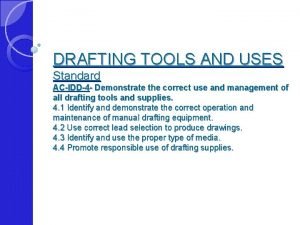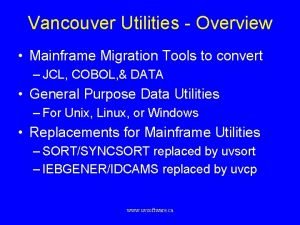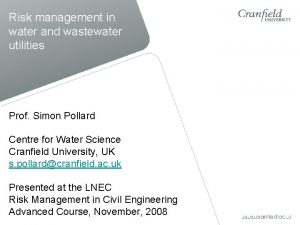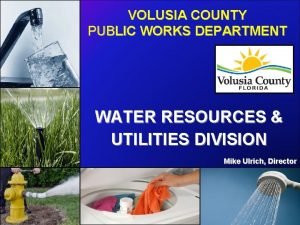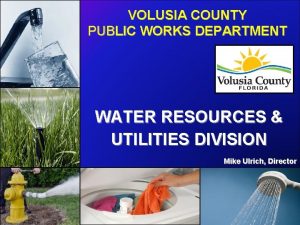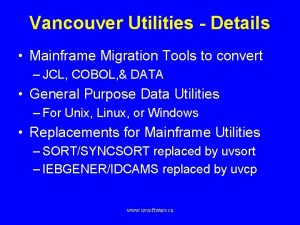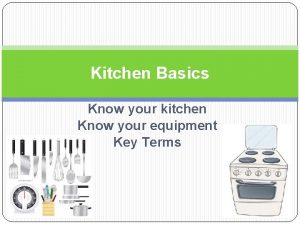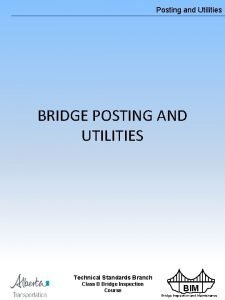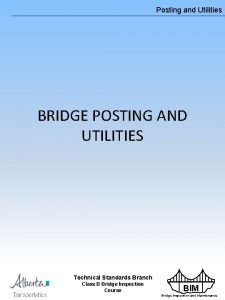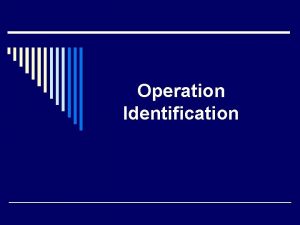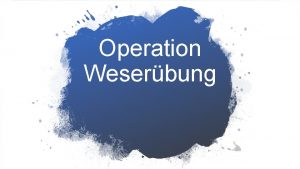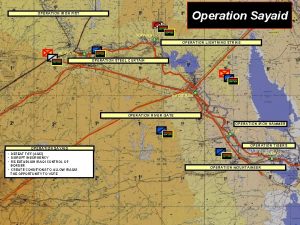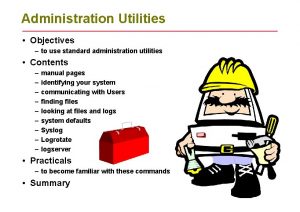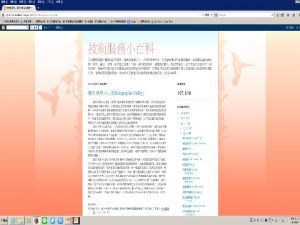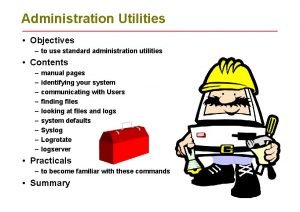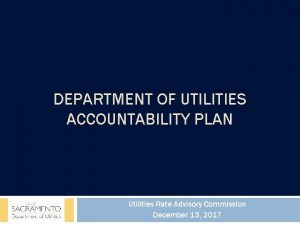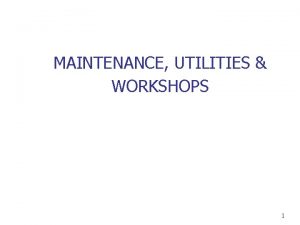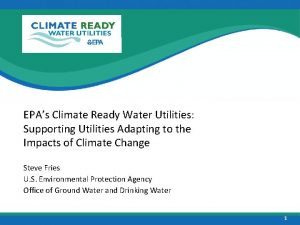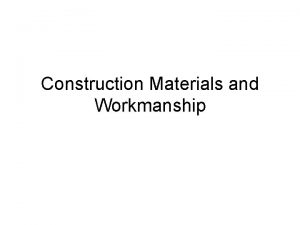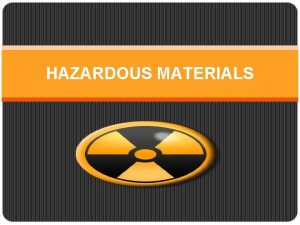The materials equipment and utilities in your operation













































- Slides: 45


• The materials, equipment, and utilities in your operation play a part in keeping food safe. • Given the opportunity, you should choose these items with food safety in mind.

• Pick smooth and durable materials- makes cleaning easier • Once installed, these items need to be maintained regularly. • Replace missing or broken ceiling tiles and flooring. Repair all holes in walls.

• Foodservice equipment must meet certain standards if it will come in contact with food. • The NSF require that it be nonabsorbent, smooth, and corrosion resistant. • Must also be easy to clean, durable and resistant to damage.

• Stationary equipment should be easy to clean and easy to clean around. • Stationary equipment should be installed: – Floor mounted equipment- on legs at least 6 inches high. Another option is to seal it to a masonry base. – Tabletop equipment- on legs at least 4 inches high; or seal it to the countertop.

• Vary by size, style and sanitizing method (some sanitize with very hot water, while others with chemicals) • Dishwashers must be installed so that they are reachable and conveniently located. The installation must also keep utensils, equipment, and other food-contact surfaces from becoming contaminated.

• Purchase dishwashers that have the ability to measure water temperature, water pressure and cleaning/sanitizing chemical concentration. • Information about the correct settings should be posted on the machine. • Clean dishwashers as often as necessary by following the manufacturer’s recommendations.

• Handwashing stations should be put in areas that make it easy for staff to wash their hands often. • Stations are required in restrooms or directly next to them. • Stations are also required in areas used for food prep, service and dishwashing. • Handwashing sinks must be used ONLY for handwashing and not for other purposes.

• Hot & cold running water- water must be drinkable and meet temperature and pressure requirements • Soap-The soap can be liquid, bar or powder • A way to dry hands- Disposable paper towels or hand dryers using either warm air or room-temperature air delivery at high velocity

• Garbage container- Garbage containers are required if disposable paper towels are used • Signage- A clearly visible sign or poster must tell staff to wash hands before returning to work.

• An operation uses many utilities and building systems. • Utilities include water, electricity, gas, sewage, and garbage disposal. • Building systems include plumbing, lighting and ventilation. • There must be enough utilities to meet the needs of the operation and they need to work correctly.

• Only water that is drinkable can be used for the preparation of food and come in contact with food-contact surfaces. • This water can come from the following sources: – Approved public water mains – Private water sources that are regularly tested and maintained – Closed, portable water containers – Water transport vehicles

• Cross-connections are the greatest risk to water safety. • A cross-connection is a physical link between safe water and dirty water, which can come from drains, sewers, or other wastewater sources.

• A Cross-connection is dangerous because it can let backflow occur. • Backflow is the reverse flow of containments through a cross-connection into a drinkable water supply. • Backflow can be the result of pressure pushing contaminants back into the water supply.

• Backflow can also happen when high water use in one area of an operation creates a vacuum in the plumbing system that sucks contaminants back into the water supply. This is called backsiphonage. • A running faucet below the flood rim of a sink is an example of a cross-connection that can lead to backsiphonage. • A running hose in a mop bucket is another example.

• The best way to prevent backflow is to avoid creating a cross-connection. • Do NOT attach a hose to a faucet unless a backflow prevention device is attached. • A vacuum breaker is a mechanical device that prevents backsiphonage. It does this by closing a check valve and sealing the water supply line shut when water flow is stopped.

• Other prevention devices include double check valves and reduced pressure zone backflow preventers. • The only sure way to prevent backflow is to create an air gap. An air gap is an air space that separates a water supply outlet from a potentially contaminated source.

• Good lighting makes it easier to clean things in your operation and provides a safer environment. • Lighting intensity—how bright the lights are in the operation—is usually measured in units called footcandles or lux. • Different areas of the facility have different lighting intensity requirements. Prep areas need to be brighter than other areas.

• Replace any bulbs that have burned out, and make sure they are the correct size. • All lights should have shatter-resistant light bulbs or protective covers. These products prevent broken glass from contaminating food or food-contact surfaces.

• Ventilation improves the air inside an operation. • It removes heat, steam, and smoke from cooking lines. It also eliminates fumes and odors. • If ventilation systems are not working correctly, grease and condensation will build up on walls and ceilings. To prevent this, get ventilation systems cleaned and maintained regularly.

• Garbage can attract pests and contaminate food, equipment and utensils if not handled correctly. • Garbage should be removed from prep areas as quickly as possible to prevent odors, pests and possible contamination. • Clean the inside and outside of garbage container frequently. This will help prevent the contamination of food and food contact surfaces.

• Containers must be leak proof, waterproof and pest proof. They also should be easy to clean. Containers must be covered when not in use. • Waste and recyclables must be stored separately from food and food-contact surfaces. The storage of these items must not create a nuisance or public health hazard. • Place outdoor garbage containers on a surface that is smooth, durable and nonabsorbent. Make sure the containers have tight-fitting lids and are kept covered at all times. Keep their drain plugs in place.

• Poor maintenance can cause food safety problems, to prevent problems: – Clean the operation on a regular basis – Make sure all building systems work and are checked regularly – Make sure the building is sound (no leaks, holes or cracks in the floors, foundation ceiling, or windows) – Control pests – Maintain the outside of the building correctly, including patios and parking lots

• Certain crisis can affect the safety of the food you serve. • Some of the most common include electrical power outages, fire, flooding and sewage backups. These are considered by the local regulatory authority to be imminent health hazards (a significant threat or danger to health that requires immediate correction or closure to prevent injury).

• Other threats that should be considered: – Temperature control- power failures and refrigeration breakdowns can threaten your ability control the temperature of TCS food. – Physical security- unauthorized people inside a facility are a risk to food safety. This is specially true when they can access storage and processing areas. Also, acts of nature can weaken a facility’s security.

• Other threats that should be considered: • Drinkable water supply- Threats to the water supply must also be considered. Broken water mains and breakdowns at water treatment facilities are a risk to the safety of food. • When faced with any of these crisis, you must first determine if there is a significant risk to the safety or security of your food. If the risk is significant, service must be stopped. Then the local regulatory authority must be notified.

• Rodents, insects, and other pests are more than just unsightly to customers. • They can damage food, supplies, and facilities. • But the greatest danger comes from their ability to spread diseases, including foodborne illness.

• Prevention is critical in pest control. Follow these three basic rules to keep your operation pest free: 1) Deny pests access to the operation. 2) Deny pests food, water and shelter. 3) Work with a licensed pest control operator (PCO).

• Pests can be brought inside with deliveries or through building openings. Follow these guidelines to prevent it: – Check all deliveries before they enter your operation for pests themselves or signs of pests (which includes egg cases and body parts) – Make sure all of the points where pests can access the building are secure. Screen all windows and vents. Seal cracks in floors and walls and around pipes. Install air curtains above or alongside doors.

• Careful cleaning eliminates the pests’ food supply and destroys insect eggs. It also reduces the places pests can take shelter. Follow these guidelines to deny pests food and shelter: – Throw out garbage quickly and correctly. Keep garbage containers clean and in good condition. Keep outdoor containers tightly covered. Clean up spills around garbage containers immediately, and wash containers regularly.

– Store recyclables in clean, pest-proof containers. Keep them as far away from your building as local regulations allow. – Store all food and supplies correctly and as quickly as possible. Keep food and supplies away from walls and at least six inches off the floor. Use FIFO to rotate products, so that pests do not have time to settle into them and breed. – Clean up food and beverage spills immediately, including crumbs and scraps.

• After denying access and shelter, if pests still are a problem work with a pest control operator (PCO) to get them under control. • Even if you only spot a few pests, they may actually be present in large numbers. This is an infestation and can be very difficult to eliminate. • Pests leave signs, letting you know that are there. Look for feces, nests, and damage on products, packaging, and the facility itself.


• What are the most important food safety features to look for when selecting flooring, wall, and ceiling materials? A. Absorbent and durable B. Hard and durable C. Porous and durable D. Smooth and durable

• What organization creates national standards for foodservice equipment? A. CDC B. EPA C. FSA D. NSF

• When installing tabletop equipment on legs, the space between the base of the equipment and the tabletop must be at least A. 2 inches B. 4 inches C. 6 inches D. 8 inches

• Besides information on chemical concentration and water temperature, what other machine setting information should be posted on dishwashing machines? A. B. C. D. Water p. H Water salinity Water pressure Water hardness

• Signage posted at a handwashing station must include a reminder to staff to A. Wash hands before returning to work. B. Use hot running water when washing. C. Scrub hands and arms for 10 to 15 seconds. D. Avoid touching faucet handles after washing.

• What is the only completely reliable method for preventing backflow? A. B. C. D. Air gap Ball valve Cross-connection Vacuum breaker

• A food handler drops the end of a hose into a mop bucket and turns the water on to fill it. What has the food handler done wrong? A. Created a cross-connection B. Created an air gap separation C. Prevented backflow D. Prevented atmospheric vacuuming

• What area of the operation is usually required to be the brightest? A. B. C. D. Dry-storage Preparation Refrigerated-storage Service

• An operation has a buildup of grease and condensation on the walls and ceiling. What is the most likely problem? A. The ventilation system is not working correctly. B. The cleaning chemicals are not being used correctly. C. The staff are not cleaning the walls correctly. D. The grill is not being operated at a highenough temperature.

• An operation received a violation in the outside area of the facility. The manager reviewed the area and saw that the Dumpster was placed on a freshly graveled drive. The lids were closed and the drain plug was in place to prevent the Dumpster from draining. What was the problem? A. The Dumpster lids should have been open allow it air out. B. The drain plug should have been removed to allow the Dumpster to drain correctly. C. The surface underneath the Dumpster should have been paved with concrete or asphalt. D. The Dumpster should have been freshly painted so that food debris would not stick to surfaces.

• A broken water main has caused the water in an operation to appear brown. What should the manager do? A. Boil the water for 1 minute before use. B. Contact the local regulatory authority before use. C. Use the water for everything except dishwashing. D. Use the water for everything except handwashing.

• What is the best way to eliminate pests have entered the operation? A. Raise the heat in the operation after-hours. B. Lower the heat in the operation afterhours. C. Work with a licensed pest control operator (PCO). D. Apply over-the-counter pesticides around the operation.
 In generators the welding current is produced on the
In generators the welding current is produced on the Cant stop the feeling trolls go noodle
Cant stop the feeling trolls go noodle Matter useful and harmful
Matter useful and harmful Man made map
Man made map Adopting and adapting teaching materials
Adopting and adapting teaching materials Drafting tools and materials
Drafting tools and materials Direct materials budget with multiple materials
Direct materials budget with multiple materials Give us your hungry your tired your poor
Give us your hungry your tired your poor Mainframe tools and utilities
Mainframe tools and utilities Risk management for water and wastewater utilities
Risk management for water and wastewater utilities Principles of information security 5th edition pdf
Principles of information security 5th edition pdf Utilities and energy lectures
Utilities and energy lectures Power and utilities investment banking
Power and utilities investment banking Mainframe tools and utilities
Mainframe tools and utilities V3700 knowledge center
V3700 knowledge center Volusia county utilities
Volusia county utilities Volusia county water
Volusia county water Cobmap
Cobmap Auxillary cooking equipment
Auxillary cooking equipment Hình ảnh bộ gõ cơ thể búng tay
Hình ảnh bộ gõ cơ thể búng tay Frameset trong html5
Frameset trong html5 Bổ thể
Bổ thể Tỉ lệ cơ thể trẻ em
Tỉ lệ cơ thể trẻ em Chó sói
Chó sói Chụp tư thế worms-breton
Chụp tư thế worms-breton Chúa yêu trần thế alleluia
Chúa yêu trần thế alleluia Môn thể thao bắt đầu bằng chữ đua
Môn thể thao bắt đầu bằng chữ đua Thế nào là hệ số cao nhất
Thế nào là hệ số cao nhất Các châu lục và đại dương trên thế giới
Các châu lục và đại dương trên thế giới Công thức tính độ biến thiên đông lượng
Công thức tính độ biến thiên đông lượng Trời xanh đây là của chúng ta thể thơ
Trời xanh đây là của chúng ta thể thơ Mật thư tọa độ 5x5
Mật thư tọa độ 5x5 101012 bằng
101012 bằng Phản ứng thế ankan
Phản ứng thế ankan Các châu lục và đại dương trên thế giới
Các châu lục và đại dương trên thế giới Thơ thất ngôn tứ tuyệt đường luật
Thơ thất ngôn tứ tuyệt đường luật Quá trình desamine hóa có thể tạo ra
Quá trình desamine hóa có thể tạo ra Một số thể thơ truyền thống
Một số thể thơ truyền thống Bàn tay mà dây bẩn
Bàn tay mà dây bẩn Vẽ hình chiếu vuông góc của vật thể sau
Vẽ hình chiếu vuông góc của vật thể sau Thế nào là sự mỏi cơ
Thế nào là sự mỏi cơ đặc điểm cơ thể của người tối cổ
đặc điểm cơ thể của người tối cổ Thế nào là giọng cùng tên?
Thế nào là giọng cùng tên? Vẽ hình chiếu đứng bằng cạnh của vật thể
Vẽ hình chiếu đứng bằng cạnh của vật thể Tia chieu sa te
Tia chieu sa te Thẻ vin
Thẻ vin





